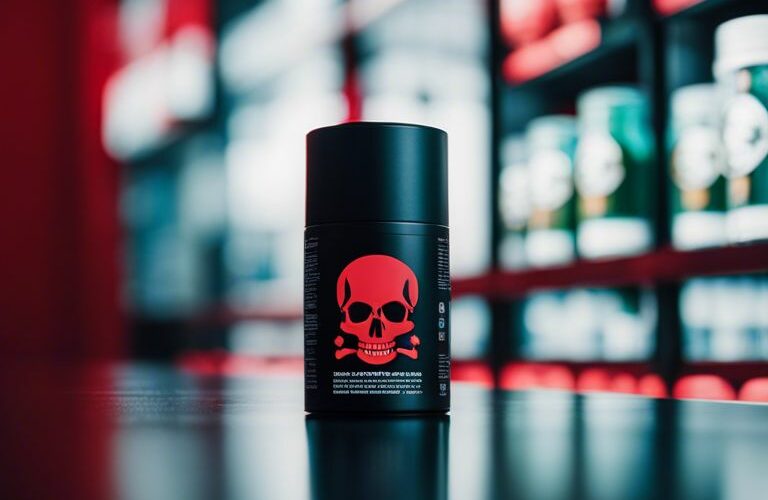Exposing the toxic truth behind mainstream deodorant products is crucial for consumer health and safety. Many popular deodorants on the market contain harmful chemicals that can have serious implications on our bodies. These potentially dangerous ingredients have been linked to various health issues, including hormonal disruption, cancer risks, and skin irritation.
Table of Contents
Key Takeaways:
- Common Chemicals: Mainstream deodorant products often contain harmful chemicals like parabens, phthalates, and aluminum compounds.
- Health Risks: These chemicals have been linked to a range of health risks, including hormone disruption, breast cancer, and skin irritation.
- Natural Alternatives: Look for deodorants that are made with natural ingredients like baking soda, coconut oil, and essential oils as safer alternatives.
- Read Labels: Take the time to read the labels of deodorant products to identify any harmful chemicals and make an informed choice for your health.
- DIY Options: Consider making your own deodorant using simple ingredients like arrowroot powder, shea butter, and tea tree oil to avoid exposure to harmful chemicals.
Understanding Deodorant Composition
Common Ingredients in Mainstream Deodorants
Any individual who picks up a mainstream deodorant product and glances at its list of ingredients might be surprised by the number of chemical compounds listed. Common ingredients found in mainstream deodorants include aluminum compounds, parabens, propylene glycol, and synthetic fragrances. These chemicals are known to act as preservatives, antiperspirants, and odor-masking agents. However, research has raised concerns about their potential health risks over prolonged use.
Some studies have suggested a potential link between aluminum compounds in deodorants and breast cancer and Alzheimer’s disease. Parabens, on the other hand, have been associated with endocrine disruption and have been found in detectable levels in breast tumors. Understanding these ingredients is crucial for consumers looking to make more informed choices about the products they use on their bodies.
Natural vs. Synthetic Ingredients
Deodorants labeled as “natural” often contain ingredients like plant-based oils, baking soda, and essential oils, which are designed to neutralize odors without the use of harsh chemicals. On the other hand, synthetic deodorants rely on artificial fragrances, preservatives, and antimicrobial agents to achieve similar results. The choice between natural and synthetic ingredients ultimately comes down to personal preference and a desire to minimize exposure to potentially harmful substances.
Deodorant products that contain aluminum compounds are typically classified as synthetic, while natural deodorants prioritize gentler, plant-based alternatives. Consumers seeking a more holistic approach to personal care may opt for natural deodorants to avoid the potential risks associated with synthetic ingredients.
Health Implications of Deodorant Chemicals
Skin Irritation and Allergic Reactions
An increasing concern among health experts is the potential harm caused by chemicals in mainstream deodorant products. Skin irritation and allergic reactions are common side effects experienced by individuals using these products. Ingredients such as aluminum compounds, parabens, and artificial fragrances can lead to redness, itching, and even more severe allergic responses in some individuals.
It is crucial to be mindful of what we apply to our skin daily, as prolonged exposure to these irritants can result in long-term damage to the skin’s natural barrier function. For individuals with sensitive skin or a history of allergic reactions, switching to all-natural or organic deodorant alternatives may help alleviate these symptoms and promote healthier skin.
Potential Links to Chronic Health Conditions
To date, research on the potential links between deodorant chemicals and chronic health conditions is ongoing. Some studies suggest a possible connection between long-term use of deodorants containing aluminum compounds and an increased risk of breast cancer or neurological disorders. While more research is needed to establish a definitive link, the potential repercussions of these chemicals on our overall health cannot be ignored.
Conditions such as endocrine disruption, hormone imbalances, and skin inflammation have also been associated with the use of certain deodorant ingredients. As awareness grows about the potential risks associated with these chemicals, consumers are encouraged to make informed choices about the products they use on their bodies to protect their health and well-being.
Specific Chemicals of Concern
Not all deodorants are created equal, and it’s essential to be aware of the harmful chemicals lurking in mainstream deodorant products. These chemicals can pose significant risks to our health and well-being, and it’s crucial to understand their potential effects.
Aluminum Compounds and Their Effects
Aluminum compounds are commonly found in antiperspirants to block sweat glands and reduce perspiration. However, research has shown that aluminum can be absorbed through the skin and accumulate in the body over time. This accumulation has been linked to potential health risks, including breast cancer, Alzheimer’s disease, and kidney problems.
Furthermore, aluminum has been associated with hormone disruption and endocrine system dysregulation, leading to imbalances in the body’s natural hormonal processes. It’s crucial to be cautious of products containing aluminum compounds and opt for safer alternatives.
Parabens and Hormone Disruption
One of the most concerning chemicals found in deodorants is parabens. These synthetic preservatives can mimic estrogen in the body and interfere with hormone function, leading to disruptions in the endocrine system. Research has linked parabens to various health issues, including reproductive problems, breast cancer, and developmental disorders.
Effects: It’s essential to check the ingredient list on your deodorant products and steer clear of those containing parabens. Opting for paraben-free alternatives can help reduce your exposure to these harmful chemicals and protect your overall health.
Phthalates and Reproductive Health
Reproductive health can be significantly impacted by exposure to phthalates, commonly found in fragrances in deodorant products. These chemicals have been linked to fertility issues, hormonal imbalances, and birth defects. It’s crucial to avoid products containing phthalates to protect your reproductive well-being.
The use of phthalate-free deodorants can help minimize your exposure to these harmful chemicals and safeguard your reproductive health in the long run.
Triclosan and Antibiotic Resistance
Effects: Triclosan, a common ingredient in antibacterial deodorants, has been associated with contributing to antibiotic resistance. Overuse of products containing triclosan can lead to the development of superbugs that are resistant to antibiotics, posing a significant threat to public health.
Any deodorants containing triclosan should be avoided to mitigate the risk of antibiotic resistance and protect the effectiveness of antibiotics for future generations.
Propylene Glycol and Neurotoxicity
Neurotoxicity: Propylene glycol, commonly found in deodorants to help retain moisture, has been linked to neurotoxic effects on the central nervous system. Prolonged exposure to propylene glycol can lead to headaches, dizziness, and even seizures in severe cases.
Choosing deodorant products free of propylene glycol can help reduce the risk of neurotoxicity and protect your neurological health in the long term.
Regulatory Overview and Labeling Loopholes
Government Regulations on Deodorant Ingredients
For many consumers, the assumption is that the use of chemicals in personal care products like deodorants is heavily regulated to ensure safety. However, the reality is quite different. While the US Food and Drug Administration (FDA) does regulate cosmetics, these regulations are much less stringent compared to other products like drugs or food. Deodorant manufacturers are not required to obtain FDA approval before their products hit the shelves, nor are they mandated to disclose all ingredients on their labels.
Furthermore, the laws that do exist regarding cosmetic safety are in dire need of an update. The FDA has minimal authority to recall harmful products and relies largely on voluntary compliance from manufacturers. This lack of strict oversight has created a situation where potentially harmful chemicals can be present in deodorant products without thorough testing or scrutiny.
The Challenge of Understanding Product Labels
The labeling on deodorant products can be confusing and misleading for consumers trying to make informed choices about their personal care products. Terms like “natural,” “organic,” or “hypoallergenic” are often used without clear definitions or regulations to back them up. Deodorant labels can also be deceptive, using scientific-sounding terms or listing chemicals by their technical names, making it difficult for consumers to understand what they are actually putting on their bodies.
The lack of transparency in labeling makes it challenging for consumers to identify potential harmful ingredients in their deodorants. Many chemicals used in these products have been linked to health issues like hormone disruption, allergies, and even cancer. It is crucial for consumers to educate themselves on how to decode product labels and be vigilant about the ingredients they are exposing themselves to on a daily basis.
The Environmental Impact of Deodorant Chemicals
Chemical Runoff and Water Pollution
After applying deodorant, the chemicals contained within can be washed away during showers or when sweating. This chemical runoff can end up in rivers, lakes, and oceans, contributing to water pollution. The most common chemicals found in deodorants, such as parabens, aluminum compounds, and triclosan, have been linked to harmful effects on aquatic life and ecosystems.
To mitigate the impact of chemical runoff from deodorants, it is crucial to opt for environmentally friendly and natural deodorant alternatives. These products are typically free from harmful chemicals and are biodegradable, reducing the environmental harm caused by traditional mainstream deodorants.
The Impact on Wildlife and Ecosystems
Impact. Deodorant chemicals that make their way into water sources can have devastating effects on wildlife and ecosystems. Aquatic organisms can be negatively affected by the presence of these chemicals, leading to disruptions in their reproductive, growth, and survival rates. Additionally, the buildup of these chemicals in the environment can have long-lasting consequences on the delicate balance of ecosystems.
Chemical runoff from deodorants can also disrupt hormone systems in wildlife, affecting their behavior and overall health. It is essential to raise awareness about the environmental impact of deodorant chemicals and encourage the adoption of sustainable practices to protect our planet’s biodiversity.
Alternatives to Conventional Deodorants
Natural and Organic Options
To find safer alternatives to conventional deodorants that are packed with harmful chemicals, consider switching to natural and organic options. These products are crafted using plant-based ingredients and are often free from synthetic fragrances, parabens, and aluminum compounds.
Brands that specialize in natural deodorants typically offer a range of scents that are derived from essential oils and other natural sources. These products help to neutralize odors without disrupting the body’s natural processes, providing long-lasting freshness without the use of harsh chemicals.
Making an Informed Choice: What to Look for
With so many natural deodorant options available on the market, it’s important to make an informed choice. Look for products that are certified organic or vegan, as these certifications indicate a commitment to using high-quality ingredients that are better for your skin and overall health.
Additionally, pay attention to the ingredient list and avoid products that contain parabens, aluminum compounds, phthalates, and artificial fragrances. Instead, opt for deodorants that include ingredients like shea butter, coconut oil, and arrowroot powder for a gentle and effective formula.
It is crucial to prioritize your health when selecting a deodorant, as the products you apply to your skin can have a significant impact on your overall well-being. Take the time to research and understand the ingredients in your deodorant to make an informed decision that supports a healthier lifestyle.
To wrap up
With these considerations in mind, it becomes evident that mainstream deodorant products may contain harmful chemicals that can pose risks to our health. From potential links to cancer and hormone disruption to skin irritation and allergies, it is crucial to be mindful of the ingredients we expose our bodies to on a daily basis.
By raising awareness about the hidden dangers of these chemicals, we can empower individuals to make informed choices when selecting personal care products. Opting for natural, aluminum-free alternatives or DIY deodorant options can help reduce our exposure to harmful substances and promote safer, healthier living practices for both ourselves and our planet.
FAQ
Q: What are some harmful chemicals commonly found in mainstream deodorant products?
A: Some harmful chemicals commonly found in mainstream deodorant products include parabens, aluminum compounds, phthalates, and triclosan. These chemicals have been linked to potential health risks such as hormone disruption, allergic reactions, and even cancer.
Q: How do parabens in deodorants affect our health?
A: Parabens are known to mimic estrogen in the body, leading to hormonal imbalances and potential reproductive issues. They have also been found in breast cancer tumors, although more research is needed to establish a direct link.
Q: What are the dangers of aluminum compounds in deodorants?
A: Aluminum compounds, such as aluminum chlorohydrate and aluminum zirconium, are commonly used in antiperspirants to block sweat glands. However, they have been associated with an increased risk of breast cancer, Alzheimer’s disease, and skin irritation.
Q: How do phthalates impact our health when present in deodorants?
A: Phthalates are used in fragrances in deodorant products to make them last longer. These chemicals are known to disrupt the endocrine system and have been linked to developmental and reproductive issues, as well as asthma and allergies.
Q: Why is triclosan a concerning ingredient in mainstream deodorants?
A: Triclosan is an antibacterial agent used in deodorants to kill odor-causing bacteria. However, it has been associated with antibiotic resistance, hormone disruption, and environmental harm. The FDA has banned its use in soaps, but it is still allowed in other personal care products like deodorants.

Our contributing author is a passionate advocate for eco-friendly living and sustainability. With a background in eco-life, they are dedicated to inspiring and empowering individuals to adopt environmentally conscious lifestyles. Through insightful articles, they share practical tips, innovative solutions, and thought-provoking perspectives to promote a greener, more sustainable world. Join them on the journey towards eco-smart living and discover how small choices can make a big impact. 🌱








